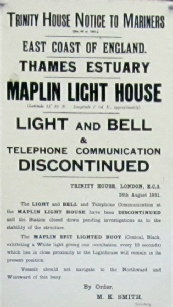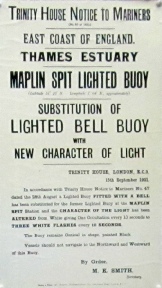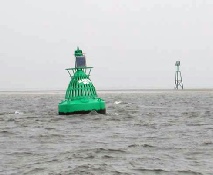
 Maplin Light House was the first screw-pile lighthouse to be built and was situated on the south eastern edge of Maplin sands north of Shoeburyness, Essex in the River Thames estuary to warn passing boats of the off shore mud flats. A screw-pile lighthouse is a lighthouse which stands on piles that are screwed into sandy or muddy sea or river bottoms.
Maplin Light House was the first screw-pile lighthouse to be built and was situated on the south eastern edge of Maplin sands north of Shoeburyness, Essex in the River Thames estuary to warn passing boats of the off shore mud flats. A screw-pile lighthouse is a lighthouse which stands on piles that are screwed into sandy or muddy sea or river bottoms.
It was constructed in 1838 as a screw pile lighthouse designed by James Walker, Trinity House’s consultant lighthouse engineer and based on the invention of an Irish man called Alexander Mitchell.
The submerged end of each pile has a broad bladed screw on it. The screw is twisted into a sand or coral bottom in the same manner that a screw is twisted into wood. A platform is then constructed upon the embedded screw piles and the living accommodation and lighthouse erected on top.
A lighthouse of this kind is easily adapted for any area where the light does not require to been seen at a great distance. The piles offer no resistance to the waves which pass through the open spaces without rising any higher than out at sea.
Maplin lighthouse was an iron lattice structure built on nine screw piles driven 22 feet into the unstable river base. Eight formed an outer octagon and the ninth a centre support on which was placed a wooden octagonal shaped living accommodation consisting of a living room, bedroom, kitchen/washroom and storeroom. The bedroom contained 3 bunks; one each for the Principal Keeper and his two assistants.
A light tower was fixed on top the living quarters. The whole structure was painted red and stood 69 feet high. It showed a fixed light at a height of 36 feet visible for 10 miles. The tower had a fog-warning bell suspended and attached to it on the seaward side of the lantern gallery. The 3cwt fog bell gave 1 stroke every 10 seconds during foggy conditions. On the other side was fixed a flagpole.

 On 26th August 1931 Trinity House posted a ‘NOTICE TO MARINERS’ stating that the Light and Bell and Telephone Communication at the MAPLIN LIGHT HOUSE would be discontinued and the station closed down pending investigations into the stability of the structure. The notice went on to state that the MAPLIN SPIT LIGHTED BUOY (Conical, black exhibiting a White light giving one occultation every 10 seconds) which lies in close proximity to the Lighthouse will remain in its present position. Vessels were advised not to navigate to the Northward and Westward of this buoy.
On 26th August 1931 Trinity House posted a ‘NOTICE TO MARINERS’ stating that the Light and Bell and Telephone Communication at the MAPLIN LIGHT HOUSE would be discontinued and the station closed down pending investigations into the stability of the structure. The notice went on to state that the MAPLIN SPIT LIGHTED BUOY (Conical, black exhibiting a White light giving one occultation every 10 seconds) which lies in close proximity to the Lighthouse will remain in its present position. Vessels were advised not to navigate to the Northward and Westward of this buoy.
On 15th September 1931 Trinity House posted another ‘NOTICE TO MARINERS’ stating that a Lighted Buoy FITTED WITH A BELL had been substituted for the former Lighted Buoy at the MAPLIN SPIT STATION and the CHARACTER OF THE LIGHT has been ALTERED from White giving One Occultation every 10 seconds to THREE WHITE FLASHES every 10 SECONDS. The Buoy remains Conical in shape painted Black. Vessels were advised not to navigate to the Northward and Westward of this buoy.
Excessive scouring of the Thames by the strength and direction of the tidal streams caused the MAPLIN LIGHT HOUSE to become undermined and it was completely swept away in 1932.
 Today the modern BLACKTAIL EAST and BLACKTAIL WEST small automatic lighthouses which were established in 1968 mark these treacherous sands.
Today the modern BLACKTAIL EAST and BLACKTAIL WEST small automatic lighthouses which were established in 1968 mark these treacherous sands.
They are both mild steel lattice structures painted green, 42 feet high, with an uninteresting navigational light on the top visible for a range of 6 miles.
For some years they were powered by experimental wind generators but they were converted to solar power in autumn 1996.




© 2015 - Richard Kirton - All Rights Reserved | Privacy Policy | Terms of Use | Site Map

